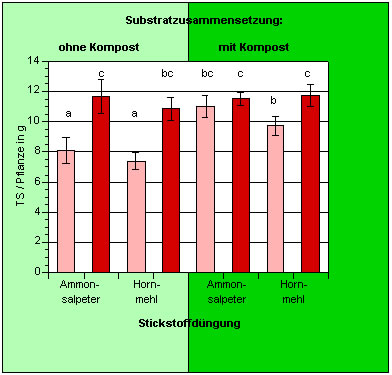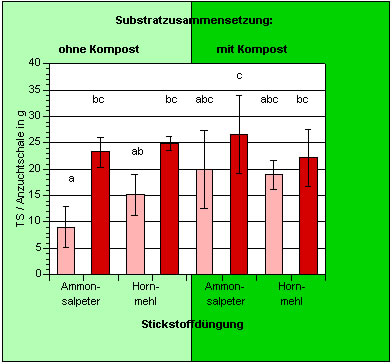|
Preliminary Result: Effect of Zeolite on Seedling Production Location:
FiBL Greenhouse
Production Setup: Tomato "Cristal
F1" (treated seed) Cauliflower "Nautilus F1"(treated seed)
Substrate:
1)
100 % peat moss
2) 70 % peat moss
3) 30 % garden compost Experimental
Matrix
| Treatment
| Peat Moss
[L]
| Compost
[L] | Zeolite
[L] | Lime
[g] | Horn Meal
[g]
(300 mg N/l) | Ammonium
Nitrate [g]
(200 mg N/l) | Thomas Meal
(95
mg/l) | Potassium Sulfate
(400 mg/l | | 1)
Peat moss + Ammonium nitrate | 40 | 0 | 0 | 400 | - | 30 | 22 | 32 | | 2)
Peat moss + Zeolite + Ammonium nitrate | 36 | 0 | 4 | 400 | - | 30 | 22 | 32 | | 3)
Peat moss + Horn meal | 40 | 0 | 0 | 400 | 100 | - | 22 | 32 | | 4)
Peat moss + Zeolite . + Horn meal | 36 | 0 | 4 | 400 | 100 | - | 22 | 32 | | 5)
Peat moss + Compost + Ammonium nitrate | 28 | 12 | 0 | 80 | - | 30 | 0 | 0 | | 6)
Peat moss+ Compost +Zeolite .+ Ammonium nitrate | 25.2 | 10.8 | 4 | 80 | - | 30 | 0 | 0 | | 7)
Peat moss + Compost + Horn meal | 28 | 12 | 0 | 80 | 100 | - | 0 | 0 | | 8)
Peat moss+ Compost +Zeolite + Horn meal | 25.2 | 10.8 | 4 | 80 | 100 | - | 0 | 0 |
The
tomatoes were top dressed with liquid fertilizer: (50 ml/pot):
-mineral fertilization:
Ammonium nitrate solution (1.8 g/l, 35 % N),
-organic fertilization: liquor
(1%, 9 % N, made with horn meal).
Experimental design: Cauliflower: 4 reps
with 77 planD each (77 planD per flat)
Tomato: 5 reps with 4 to 5 poD each,
one plant per pot Data collected: - Chemical
und physical parameters of the substrate, such as water holding capacity and solubility
of micronutrienD.
- Fresh and dry weight of shooD and rooD for both cauliflower
and tomato seedlings. In addition, the height of the tomato seedlings was measured.
- Micronutrient
content of tomato and cauliflower shooD.
Harvest:
Cauliflower 28. May 2001 (cropping period: 38 days)
Tomato 6.
June 2001 (cropping period: 68 days, 47 days since transplanting) Statistical
Analysis:
A multifactorial analysis of variance was performed on each experimental
factor (zeolite, compost, fertilization) and on their interactions. Example: The
interaction "Zeolite * Compost" is significant, if the effect of zeolite
is different with or without the addition of compost. Tomato: 
Cauliflower 
Significant
Differences in the Tomato Experiment: Parameter
F=
fresh weight
D=dry weight
| Zeolite
+Z:
with Zeolite
-Z: without Zeolite
| Compost
+K: with Compost
-K: without Compost
| N-Fertilizer
(ASP= Ammonium nitrate, HM=Horn meal
| Zeolite
*Comp | Zeolite *Fertilizer | Compost*
Fertilizer | Compost
*Zeolite * Fertilizer | | Shoot: | *** | *** | Ns | *** | ns | ns | Ns | | F/Plant
in g | +Z (69) > -Z (57) | +K
(66) > -K (60) | | | | | | | Shoot: | *** | *** | * | *** | ns | ns | Ns | | D/Plant
in g | +Z (11) > -Z (9.1) | +K
(11) > -K (9.5) | ASP (11) > HM (9.9) | | | | | | Shoot:
D in % | ns (p=0.07) | * | * | Ns | ns | ns | Ns | | Root: | *** | *** | Ns | Ns | ns | ns | Ns | | F/Plant
in g | +Z (8.3) > -Z (6.7) | +K
(8.1) > -K (6.8) | | | | | | | Root: | Ns | ns | Ns | Ns | ns | ns | Ns | | D/Plant
in g | +Z (0.9) > -Z (0.8) | +K
(0.9) > -K (0.8) | | | (p=0.06) | | | | Root:
D in % | Ns | ns | Ns | Ns | ns | ns | Ns |
n.s.:
not significant; * : p < 0.05
**: p < 0.01 *** : p < 0.001 Both
roots and shoots exhibited increased weight with the addition of zeolite and compost.
Without compost, the beneficial effect of zeolite was more pronounced. The dry
matter share of the shoot is increased with the addition of compost or ammonium
nitrate. Significant Interactions between Zeolite und Compost:
| While
the effect of zeolite is small if compost is added (+3 %), yield can be greatly
increased (+34 %) in the absence of compost. |  |
Significant
Differences in the Cauliflower Experiment: Parameter
F=
fresh weight
D=dry weight
| Zeolite
+Z:
with Zeolite
-Z: without Zeolite
| Compost
+K: with Compost
-K: without Compost
| N-Fertilizer
(ASP= Ammonium nitrate, HM=Horn meal
| Zeolite
*Comp | Zeolite *Fertilizer | Compost*
Fertilizer | Compost
*Zeolite * Fertilizer | | Germination
| * | * | Ns | ns | ns | ns | ns | | Rate
in % | +Z (77) > -Z (69) | -K
(77) > +K (69) | | | | | | | Shoot
F/plant | ** | ns | Ns | * | ns | ns | ns | | Shoot
D/ plant | *** | *** | Ns | * | ns | ns | ns | | | +Z
(0.4) > -Z (0.3) | +K(0.4) > -K (0.3) | | | | (p
=0.07) | | | Shoot D in
% | ns | ** | Ns(p
=0.07) | ns | ns | ns | ns | | | | +K
(11) > -K (9.3) | | | | | | | Root
F / plant | ** | ** | Ns | * | ns | ns | ns | | | +Z
(0.5) > -Z (0.4) | +K (0.5) > -K (0.4) | | | | | | | Root
D/ plant | ns | ns | Ns | ns | ns | ns | ns | | Root
D in % | ns | ns | Ns | ns | ns | ns | Ns |
n.s.:
not significant; * : p < 0.05
**: p < 0.01 *** : p < 0.001 Most
results of the tomato experiment were confirmed by the cauliflower experiment.
In addition, the germination rate for cauliflower was detrmined: with zeolite
and without compost, germination of cauliflower was significantly higher. Conclusion: A
final evaluation of the effect of zeolite on seedling production can only be drawn
after all outstanding data is available for analysis. These parameters are the
physical quality of the substrate, micronutrient solubility in the substrate,
and microntrient content of the plants at the end of the experiment. The
available data allows the following conclusions: - In this experiment,
zeolite has improved seedling growth.
- This beneficial effect of zeolite
was more pronounced in the substrates without compost.
- The source of nitrogen
fertilization had no influence on plant growth.
- Shoot dry weight showed
the biggest differences.
| 


